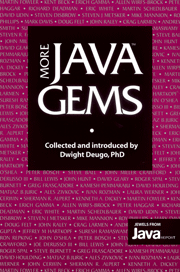Book contents
- Frontmatter
- Contents
- INTRODUCTION
- GETTING STARTED WITH JAVA
- MIGRATING TO JAVA
- TECHNIQUES 101
- MODELING AND PATTERNS
- JAVA IN A DISTRIBUTED WORLD
- THREADS
- USER INTERFACES
- SECURITY
- TESTING
- PERFORMANCE
- COMPLEX JAVA APPLICATIONS: BREAKING THE SPEED LIMIT
- ARE DISTRIBUTED OBJECTS FAST ENOUGH?
- EFFICIENT TEXT SEARCHING IN JAVA
- ENTERPRISE APPLETS AND ARCHIVE FUNCTIONALITY
- REALITY CHECK
- INDEX
EFFICIENT TEXT SEARCHING IN JAVA
Published online by Cambridge University Press: 06 July 2010
- Frontmatter
- Contents
- INTRODUCTION
- GETTING STARTED WITH JAVA
- MIGRATING TO JAVA
- TECHNIQUES 101
- MODELING AND PATTERNS
- JAVA IN A DISTRIBUTED WORLD
- THREADS
- USER INTERFACES
- SECURITY
- TESTING
- PERFORMANCE
- COMPLEX JAVA APPLICATIONS: BREAKING THE SPEED LIMIT
- ARE DISTRIBUTED OBJECTS FAST ENOUGH?
- EFFICIENT TEXT SEARCHING IN JAVA
- ENTERPRISE APPLETS AND ARCHIVE FUNCTIONALITY
- REALITY CHECK
- INDEX
Summary
Text searching and sorting is one of the most well researched areas in computer science. It is covered in an introductory algorithms course in nearly every engineering school, and there are entire books devoted to the subject. Why then, you might ask, is it necessary to publish yet another article about searching?
The answer is that most of the well-known, efficient search algorithms don't work very well in Unicode, which includes the char type in Java. Algorithms such as Knuth–Morris–Pratt and Boyer–Moore utilize tables that tell them what to do when a particular character is seen in the text being searched. That's fine for a traditional character set such as ASCII or ISO Latin-1 where there are only 128 or 256 possible characters.
Java, however, uses Unicode as its character set. In Unicode, there are 65,535 distinct characters that cover all modern languages of the world, including ideographic languages such as Chinese. In general, this is good; it makes the task of developing global applications a great deal easier. However, algorithms like Boyer–Moore that rely on an array indexed by character codes are very wasteful of memory and take a long time to initialize in this environment.
And it gets worse. Sorting and searching non-English text presents a number of challenges that many English speakers are not even aware of. The primary source of difficulty is accents, which have very different meanings in different languages, and sometimes even within the same language:
Many accented letters, such as “é” in “cafe”, are treated as minor variants on the letter that is accented, in this case “e”.
[…]
- Type
- Chapter
- Information
- More Java Gems , pp. 405 - 420Publisher: Cambridge University PressPrint publication year: 2000



